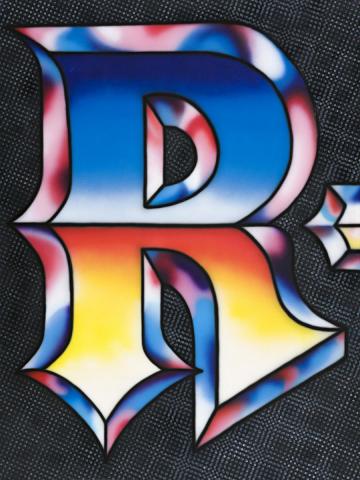RRRRR ART, 1994
HOWARD ARKLEY
synthetic polymer paint on canvas
203.5 x 152.5 cm
signed, dated and inscribed verso: Name Howard Arkley / Date 1994 / Title Rrrrr Art / ...
Private collection, Melbourne
1996 Preview, Tolarno Galleries, Melbourne, November 1995, cat. 11 (label attached verso)
Australia Felix, Benalla Art Gallery, Victoria, 1995
Crawford, A., and Edgar, R., Spray: The Work of Howard Arkley, Craftsman House, Sydney, revised edition 2001, p. 112 (illus.)
Arkley Works electronic catalogue raissoné reference: http://arkleyworks.com/?p=5869
© The Estate of Howard Arkley. Licensed by Kalli Rolfe Contemporary Art
When one says the word 'art' what is the letter that takes over? The 'a' is essentially silent, not like aorta or accordion. We barely hear the 'a'. And the 't' is simply tacked on at the end, slightly abruptly. Indeed, the word could well be spelt rrrrr-t.
With its pseudo-Gothic grandeur, this work is a form of homage to the subject that Howard Arkley loved. Even as he was creating his own aesthetic milestones and watching his own career and success expand exponentially, Arkley would still attend other artists' openings and relish getting into heated discussions with such peers as Juan Davila and Callum Morton about the potential aesthetics they could explore.
If Arkley had a problem here it was that to his eye it was all rrrrrt - whether it was an over flying highway or the fly-screen of a suburban home, rrrrrt was everywhere.
Arkley's choice of Gothic script here no doubt had two key sources. Firstly, growing up and then, in adulthood, returning to the suburbs Arkley would clearly have registered the suburban tendency to 'name' houses. In their kitsch but harmless way a common sight was to see a humble brick-veneer house named rather grandly 'Camelot' or something of equally suggestive grandeur. Inevitably, it seemed, the font of choice was Gothic.
At the same time Arkley was forever enamoured of youth culture, whether it was Street Art or Heavy Metal music. And again, in a pattern that seems to contradict their parents' mainstream style of naming their homes, the choice in those sub-cultures was also Gothic. While Arkley himself remained a fan of early punk a la The Ramones and The Pogues, he was hyper-aware of the usage of Gothic fonts by such bands as Motorhead and Metallica. These in turn spawned a stylistic generation of street artists who shared Arkley's love of the spray gun and Arkley in turn helped spawn a younger generation of artists who often started out making art on the street.
But there is perhaps another reason for this particular typeface. If Arkley had a religion it was art, and the Blackletter typeface (most often referred to as Gothic or Old English) was used in the Gutenburg Bible, one of the first books printed in Europe. The font lends a particular and distinct gravitas to its subject. Rrrrrt for Arkley was a serious zone of endeavor. He, more than most, certainly knew how to have fun with art, but the result had to have significance. Thus the colours utilised here. The bottom half of Rrrrr art, with its burning-hot yellow and red embers suggests that art must stem from passion, to grow from the heat of the idea, whilst the sharply contrasting cool, cerebral ultramarine suggests that such passion must be tempered.
The asterisk that abets the R is cut abruptly. One might surmise that this was initially one third of a planned triptych that would have run across three canvases: A*R*T but Arkley perhaps decided that was unnecessary - it was all Rrrrrt anyway.
ASHLEY CRAWFORD
